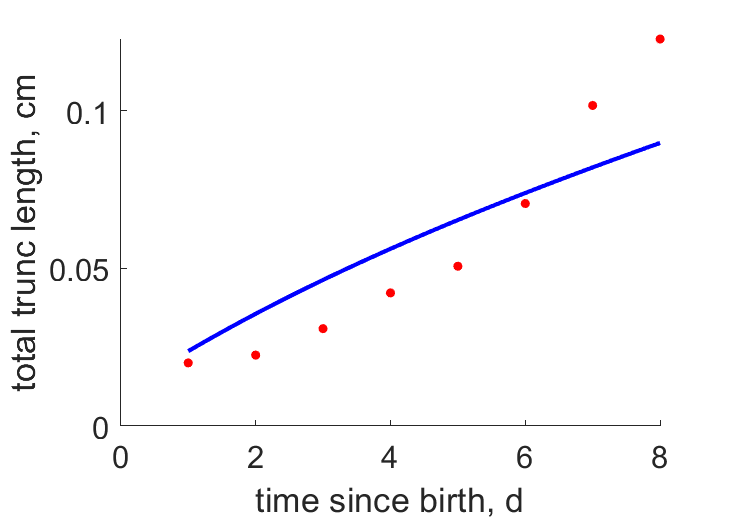Predictions & Data for this entry
| Model: std | climate: MC | migrate: | phylum: |
| COMPLETE = 2.5 | ecozone: MC | food: biPn | class: |
| MRE = 0.209 | habitat: 0iMp | gender: D | order: |
| SMSE = 0.235 | embryo: Mp | reprod: Os | family: |
Zero-variate data
| Data | Observed | Predicted | (RE) | Unit | Description | Reference |
|---|---|---|---|---|---|---|
| ab | 0.33 | 0.3309 | (0.002678) | d | age at birth | Fena1998 |
| am | 8 | 7.934 | (0.008281) | d | life span | Fena1998 |
| Lb | 0.0115 | 0.009447 | (0.1785) | cm | total trunc length at birth | LombScia2009 |
| L8 | 0.1226 | 0.09626 | (0.2149) | cm | total trunc length at 8 d | LombScia2009 |
| Wdb | 0.4 | 0.03123 | (0.9219) | mug | dry weight at birth | LombScia2009 |
| Wd8 | 52.6 | 48.32 | (0.08134) | mug | dry weight at 8 d | LombScia2009 |
| NR | 164.6 | 163.3 | (0.008379) | # | total number of eggs at death | LombScia2009 |
Uni- and bivariate data
| Data | Figure | Independent variable | Dependent variable | (RE) | Reference |
|---|---|---|---|---|---|
| tL |  | time since birth | total trunc length | (0.2535) | LombScia2009 |
Pseudo-data at Tref = 20°C
| Data | Generalised animal | Oikopleura dioica | Unit | Description |
|---|---|---|---|---|
| v | 0.02 | 0.042 | cm/d | energy conductance |
| kap | 0.8 | 0.2 | - | allocation fraction to soma |
| kap_R | 0.95 | 0.95 | - | reproduction efficiency |
| p_M | 18 | 1300 | J/d.cm^3 | vol-spec som maint |
| k_J | 0.002 | 0.001 | 1/d | maturity maint rate coefficient |
| kap_G | 0.8 | 0.6852 | - | growth efficiency |
Discussion
- Reprod buffer builds up on trunk, so the basis growth with L^2, and contribution to total trunc length with N/L^2
- Allocation to reproduction starts at birth, so E_Hp = E_Hb
- Parameters tuned by hand
Facts
- Produces a new house each 2 h (marine snow) (Ref: Wiki)
- dies at first spawning (Ref: Wiki)
Bibliography